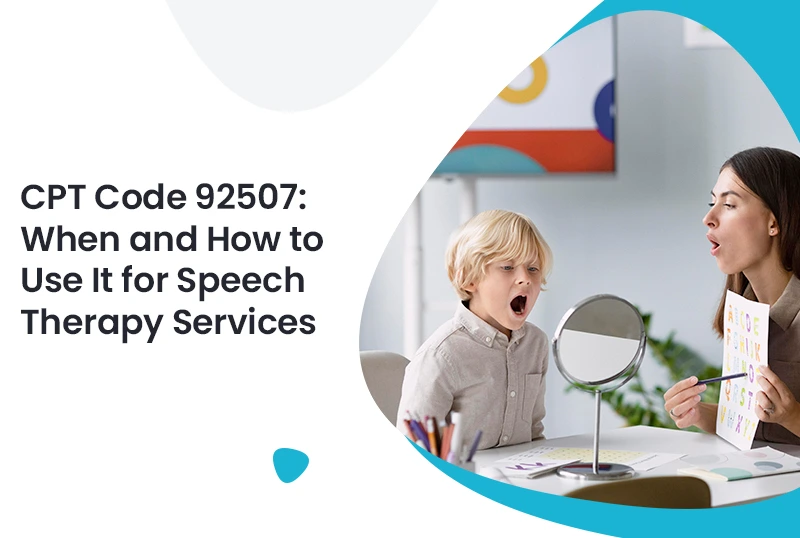Our speech therapy teams deliver accurate claims and clinical excellence in every evaluation. We leverage medical billing services for small practices to streamline submission. Providers gain clarity on coverage and coding guidelines. Implementing correct codes reduces denials and improves cash flow. Speech-language pathologists often overlook essential documentation details. This guide shows you actionable steps for correct CPT usage. You will learn code definitions, documentation tips, and billing strategies. Follow these practices to optimize reimbursement and patient outcomes.
Understanding This CPT Code and When to Apply It
92507 cpt code defines a full speech-language evaluation service. It combines case history review, norm-referenced tests, and interpretive reporting. Clinicians administer formal tools such as the CELF-5 and GFTA-3. You must record each test name and patient score. A thorough report supports therapy planning and payer audits. Avoid using this code for brief screenings or monitoring. Use it for initial or re-evaluation assessments that need depth. Correct code selection reflects clinical expertise and maximizes revenue. We update our templates with annual CPT code revisions. Clinicians check CPT bulletins for accurate code descriptions.
Clinical Indications and Appropriate Use
Clinicians should select 92507 cpt code when diagnosing complex speech disorders such as childhood apraxia. Evaluate adult patients who show aphasia after neurological events, like stroke. Apply the code for dysphonia or persistent voice quality concerns. Document specific symptoms and history before scheduling the assessment. Do not bill it for progress checks or routine therapy sessions. Separate treatment visits require different codes and clear modifiers. Explain clinical necessity in your notes to avoid payer pushback. Align service selection with patient needs and evidence-based practice guidelines. Detail coexisting conditions that influence speech and language outcomes. Collaborate with families to confirm symptom reports and history.
Key Documentation Requirements
- Record precise start and end times for each evaluation.
- List all assessment tools and versions used.
- Document patient medical history, family reports, and symptom duration.
- Include detailed error analysis and normative score comparisons.
- Summarize clinical impressions with clear therapy recommendations.
- Use structured templates and headings for consistent, auditor-friendly notes.
Billing Guidelines and Modifier Use
Always submit 92507 cpt code with accurate date and time units. Use modifier 25 when you bill evaluation with treatment on the same day. Apply modifier 59 to denote distinct procedural services only. Avoid bundling evaluation and therapy without proper documentation. List the code, modifiers, and service minutes on the claim form. Check CPT guidelines monthly to stay current on updates. Educate your billing team on payer-specific modifier rules. Validate each claim with electronic scrubbing software before submission. Maintain a fee schedule aligned with current CPT valuations. Report any coding uncertainty to your compliance officer promptly.
Explore further insights read here: modifier 52, modifier 57, modifier 58
Telehealth Adaptations and Coding
Secure, HIPAA-Compliant Video Platform
- Use an approved, secure video platform for all telepractice sessions and document the delivery method.
Technical Interruption Documentation
- Record any connectivity issues or technical disruptions in your service notes to justify session length and billing.
Validated Remote Assessment Tools
- Employ only those assessment instruments that have been validated for virtual use.
Accurate Screen-to-Screen Time Logging
- Track and log actual face-to-face video time to ensure correct time-based billing.
Payer Policy & Patient Consent Verification
- Confirm that payers recognize telehealth codes under current policies and document patient consent at each session start.
Payer-Specific Rules and Reimbursement Rates
Medicare Part B covers 92507 cpt code under its physician fee schedule. Medicaid reimbursement varies across states and often limits frequency. Private insurers may require pre-authorization for comprehensive assessments. Review each payer’s policy before scheduling an evaluation service. Appeal quickly if a claim denies due to missing details. Partner with payers through direct contacts to resolve denials. Track reimbursement timelines to spot slow-paying insurers. Update your internal fee schedule based on actual payment data. Negotiate contracts to secure higher reimbursement rates when possible. Update your payer matrix regularly to reflect policy changes.
Common Pitfalls and Avoidance Strategies
Misreporting screening codes instead of full evaluations leads to underbilling. Forgetting to include normative score tables triggers claim denials. Skipping modifiers when bundling services risks payment rejections. Incomplete patient histories undermine medical necessity claims. Regular audits catch these errors before you submit claims. Use coding checklists to verify each documentation element. Share denial trends with your clinical team for targeted training. Address recurring issues promptly to improve clean-claim rates. Apply a root cause analysis for frequent coding mistakes. Reinforce accountability by assigning claim reviews to senior coders.
Best Practices for Claims Success
Implement robust (RCM) Services in your workflow. Pre-verify benefits and coverage before scheduling evaluations. Standardize documentation templates across all clinicians and assistants. Host quarterly code update trainings for your billing staff. Leverage electronic health record features for time and code tracking. Run weekly clean-claim rate reports to measure improvement. Use denial data to refine 92507 cpt code documentation and submission workflows. Encourage open communication between clinicians and billing specialists. Implement automated alerts for missing documentation or incorrect codes. Benchmark your clean-claim rates against industry standards each quarter.
Auditing, Reporting, and Continuous Improvement
Conduct monthly claim audits to spot documentation gaps. Compare 92507 cpt code denial reasons to identify recurring mistakes. Update internal policies based on audit findings and feedback. Visualize key metrics with dashboards for quick insights. Celebrate improvements to motivate staff and reinforce best practices. Integrate audit results into clinician performance reviews and training. Adjust workflows to streamline evaluation documentation and billing. Maintain transparency with stakeholders through clear, concise reporting. Share key performance indicators with leadership to drive improvements. Allocate resources for coding expertise to address complex reimbursement issues.
Conclusion
Mastering 92507 cpt code elevates practice revenue and care quality. Thorough documentation, active billing workflows, and regular audits support success. Precision Hub offers specialized medical credentialing services to streamline provider enrollment. We also deliver expert medical billing solutions and revenue cycle support. Let Precision Hub optimize your claims so you can focus on patients. Contact Precision Hub today to enhance your speech therapy practice billing. Partnering with Precision Hub ensures ongoing compliance and optimized cash flow. Book a consultation today to transform your speech therapy billing process.
Frequently Asked Questions (FAQs)
- What is CPT code 92507?
It’s a comprehensive speech-language evaluation combining case history review, standardized testing, and interpretive reporting.
It assesses language, articulation, cognition, fluency, and voice quality. - When should I use CPT code 92507?
Use it for initial or re-evaluation assessments that require in-depth testing, not for brief screenings or routine progress checks.
Document clinical necessity clearly to justify the full evaluation. - Can I bill 92507 via telehealth?
Yes, when you document the HIPAA-compliant platform and obtain patient consent at each session.
Employ validated remote assessment tools and log actual screen-to-screen time. - What documentation is required for 92507?
Record precise start/end times, list all test instruments, and detail patient history with symptom duration.
Include error analyses, normative score comparisons, and clear therapy recommendations. - How do modifiers affect billing for 92507?
Apply modifier –25 when billing evaluation alongside treatment on the same date.
Use modifier –59 to indicate distinct procedural services for correct reimbursement.





